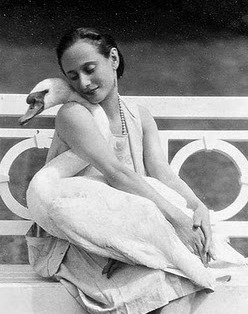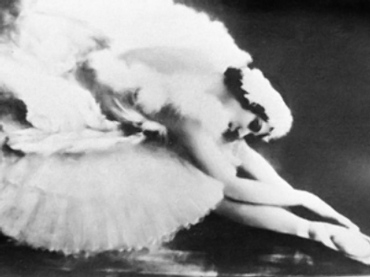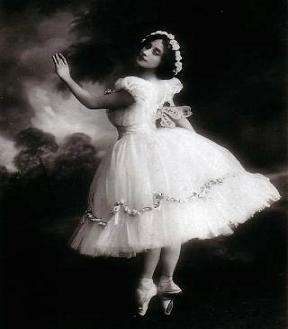 |
| Anna Pavlova and Swan (http://ann-lauren.blogspot.com/2009/02/19-20th-cent-ballerina-anna-pavlova.html) |
"Talent is cheaper than table salt. What separates the talented individual from the successful one is a lot of hard work" (Stephen King). Stephen King's quote describes Anna Pavlova's ballet career. Anna Pavlova was born on January 31, 1881 in St. Petersburg, Russia. Pavlova dreamed of becoming a ballerina after her mother took her to see "Sleeping Beauty" at the Maryinsky Theatre at the age of eight. The performance amazed the young child, and from that moment on she only hoped to be as beautiful as Princess Aurora one day. Pavlova's training at St. Petersburg's Imperial Ballet School, now known as Vagnova Ballet Academy, began at the age of ten. After graduating in the year 1902, Pavlova's career took off after she joined the Maryinsky Theatre. By 1906 Anna received the title as "prima ballerina". She traveled to a variety of different places and appeared in over four thousand performances. (Andros) At first Pavlova's slender frame did not receive any positive comments from Pavlova's audience or mentors. However, Pavlova turned her body into a work of art by embracing her god given talents and developing a form of ballet that suited her image. Pavlova described her experience with Michel Fokine and her piece “The Dying Swan” as “a huge impact on my terrific career. In 1905, he choreographed a dance just for me. It is called “The Dying Swan”. The swan character has such a strong resemblance towards me. We are both so frail and agile. I absolutely love performing that dance. I just feel such a strong connection to it” (Pavlova). Anna Pavlova’s hard work made ballet famous around the world, and she proved that having imperfections will never stop someone from succeeding to reach their dreams.
 |
| Anna Pavlova in |
Pavlova took part in globe-covering tours to share her talent and love for ballet. Pavlova traveled thousands of miles so she could share the art of ballet with the world. "In 1913 she toured America, and for the next fifteen years, countless other countries--a total of 300,000 miles and 4000 performances" (Andros). Appearing in four thousand performances which were held overseas in fifteen years was a challenge back then, and it still is a challenge in our modern world. However, Anna's love for ballet gave her the strength to make those exhausting trips across the globe. Pavlova devoted her life to performing and sharing. During each performance, Pavlova pulled in the audience's attention and made them fall in love with each move she performed. "...her performances filled people with a love for the dance. In this way, she helped bring ballet to heights of appreciation and admiration that it had never reached before" (Heckenkamp). Her determination to spread the beauty of dance worldwide became a success when she captured the hearts of her audience. Anna introduced a new form of art that could be appreciated by the world and made ballet famous. Along with introducing ballet, Pavlova shared her astonishing technique. “There was simply no critical vocabulary for what it was that Pavlova did—all agreed exquisitely—on stage; writers were reduced to calling Pavlova's faultless pirouettes "twirls" and the ballets themselves "ocular operas"(Smeltzer). These flawless pirouettes are the result of Pavlova’s hard work. She spent her whole life perfecting these movements and showed seriousness for ballet. The effort Pavlova put into entertaining the world resulted in millions of viewers being awestruck by the incredible performances she gave.
Anna Pavlova used her imperfections and turned them into strengths. Pavlova took advantage of her physical form and portrayed ballet in a new way. "Anna made the most of her slender frame and danced the way she was made to dance, moving gracefully, expressing emotion with her flexible body” (Heckenkamp). Anna constantly received critiques and foul comments about her small body. These negative words impacted Anna in a positive way. She created a new style of ballet that worked for her physique. Pavlova's ability to disguise her flaws and perform in an incomparable way stunned her audience. Her weaknesses gave her the chance to show a different form of elegance. In order to transform in such a way, Pavlova altered her pointe shoes to fit the shape of her foot. "So that she could stay on her toes longer, Anna reinforced her pointe shoes with leather stitching" (Heckenkamp). Her pointe shoes changed the way her feet moved, turned, and pointed. Changes made on Anna's shoes show her determination to get rid of any reason for not being able to dance. Although negative comments were constantly thrown in Anna's direction, she worked diligently to make ballet fit her imperfections and image. Anna took the criticism about her physical appearance in a positive way and transformed her body to be beautiful in its own way.
 |
| Anna Pavlova (http://www.russinitalia.it/dettaglio.php?id=277) |
Pavlova's achievements inspire others to reach for their own goals. In an interview conducted by Ellen Ersham, Anna Pavlova said, “From then on, all I thought of was dancing professionally. I knew that I could do it as long as I put in my best effort. And look at me today. That work must have really paid off” (Pavlova). The dancer set her mind on her goal and did not let her imperfectness stop her from reaching the dream she always hoped on fulfilling. "God gives talent. Work transforms talent into genius" (Pavlova). God gave Pavlova two talents. One talent she received was her ability to evolve her flaws into perfection. The second talent was her ability to portray dance in an unusual way. Pavlova combined these two talents and shaped her path to “genius”. Any obstacle thrown in Anna's path was overcome. She never let the audience doubt her abilities and gave her best performance every time. Anna's perseverance to never let anything get in between her and dance is something that will always be admired. A person who is worthy of the title hero should have the strength to embrace their flaws and always give their best effort in hopes to achieve greatness one day.
Nov. 1994. Web. 13 Dec. 2010. http://michaelminn.net/andros/biographies/pavlova_anna/.
Goodreads Inc, prod. "Quote by Stephen King." Goodreads. Goodreads Inc, 2011. Web. 10 Jan. 2011.
http://www.goodreads.com/quotes/show/76668.
Heckenkamp, Therese. "A princess of ballet." Hopscotch Dec. 2009: 22+. General Reference Center Gold. Web. 14 Dec. 2010.
Heckenkamp, Therese. "A princess of ballet." Hopscotch Dec. 2009: 22+. Gale Student Resources In Context. Web. 14 Dec. 2010.
Matheson, Katy. "Pavlova, Anna." World Book Advanced. World Book, 2010. Web. 16 Dec. 2010.
Pavlova, Anna. "An Interview with Anna Pavlova ." Interview by Ellen Ersham. Scribd. N.p., Mar. 2007. Web. 10 Jan. 2011.
http://www.scribd.com/doc/29815956/An-Interview-With-Anna-Pavlova.
"Pavlova, Anna." UXL Encyclopedia of World Biography. Ed. Laura B. Tyle. Vol. 8. Detroit: UXL, 2003. 1462-1464. Gale
Virtual Reference Library.
Web. 9 Dec. 2010.
"Pavlova, Anna (1881-1931)." Encyclopedia of World Biography. Detroit: Gale, 1998. Gale Student Resources In Context. Web. 13 Dec. 2010.
Page created on 1/21/2011 12:00:00 AM
Last edited 10/18/2019 5:26:28 PM
